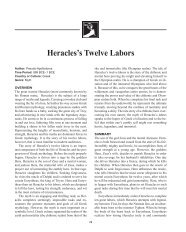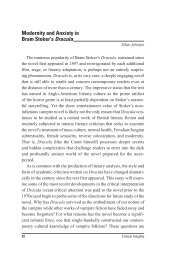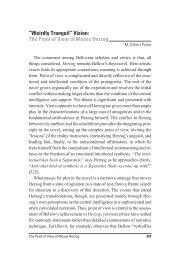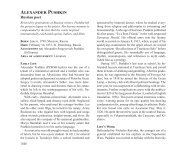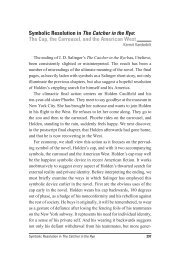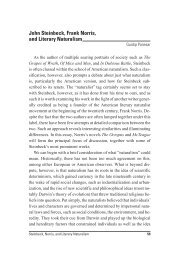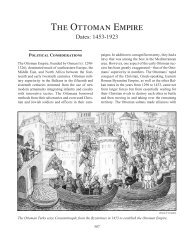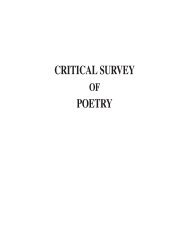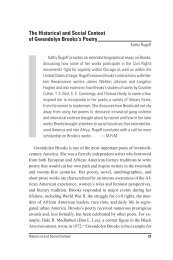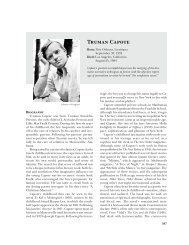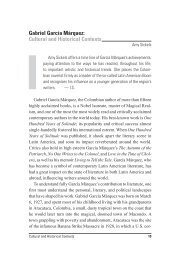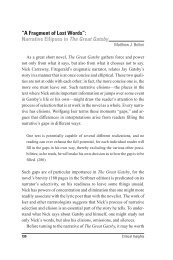Introduction to Poe Criticism Overview: Poe and the ... - Salem Press
Introduction to Poe Criticism Overview: Poe and the ... - Salem Press
Introduction to Poe Criticism Overview: Poe and the ... - Salem Press
Create successful ePaper yourself
Turn your PDF publications into a flip-book with our unique Google optimized e-Paper software.
point about <strong>the</strong> nature of <strong>the</strong> unconscious. Like many critics working<br />
from psychoanalytic paradigms, in effect she treats <strong>Poe</strong> as a patient,<br />
examining his life <strong>and</strong> his work for clues <strong>to</strong> his psyche. She analyzes<br />
his tales as a psychoanalyst would parse a patient’s dreams: searching<br />
out <strong>the</strong> hidden symbolism that reveals <strong>Poe</strong>’s inner conflicts. Taking up<br />
“The Black Cat,” for example, she argues that <strong>the</strong> narra<strong>to</strong>r, whom she<br />
identifies with <strong>Poe</strong>, displaces his hatred of his mo<strong>the</strong>r on<strong>to</strong> <strong>the</strong> allblack<br />
cat, which he mutilates <strong>and</strong> kills for biting him. He is able, for a<br />
time, <strong>to</strong> regard <strong>the</strong> second cat as a good mo<strong>the</strong>r, because this one has a<br />
large splotch of white on its breast. The splotch, by its color <strong>and</strong> location,<br />
represents a mo<strong>the</strong>r’s milk; moreover, <strong>the</strong> second cat is found in a<br />
tavern (where one drinks), a<strong>to</strong>p a barrel of liquor.<br />
Bonaparte’s work is controversial. On one h<strong>and</strong>, she is praised for<br />
her keen insight in<strong>to</strong> <strong>the</strong> symbolic imagery in <strong>Poe</strong>’s tales. On <strong>the</strong> o<strong>the</strong>r<br />
h<strong>and</strong>, she is faulted, first, for her complete adherence <strong>to</strong> Freud’s <strong>the</strong>ories<br />
(which <strong>to</strong>day few analysts accept in <strong>the</strong>ir entirety) <strong>and</strong>, second, for<br />
her identification of <strong>Poe</strong> <strong>the</strong> man with his tales. The latter is an important<br />
issue, in terms of both <strong>Poe</strong>’s work in particular <strong>and</strong> our ideas about<br />
how <strong>to</strong> think about literature.<br />
Bonaparte takes <strong>Poe</strong>’s tales as expressions of himself. <strong>Poe</strong> writes <strong>the</strong><br />
tale; Bonaparte explains what it reveals about him. But while dreams<br />
may be <strong>the</strong> products of <strong>the</strong> dreamer’s unconscious, is not a short s<strong>to</strong>ry<br />
largely a conscious creation? <strong>Poe</strong> thought about how <strong>to</strong> draw his character,<br />
what setting <strong>to</strong> place him in, what would happen <strong>to</strong> him, <strong>and</strong> what<br />
he would say about <strong>the</strong>se things. How ought we <strong>to</strong> think about <strong>the</strong> end<br />
product: in terms of what it tells us about <strong>Poe</strong>, or what <strong>Poe</strong> is trying <strong>to</strong><br />
tell us about <strong>the</strong> world?<br />
An example may clarify this idea. Nathaniel Hawthorne, in tales<br />
such as “The Birthmark” <strong>and</strong> “Rappaccini’s Daughter,” writes of men<br />
who exhibit fears of women <strong>and</strong> end up killing <strong>the</strong>m. Yet few critics or<br />
general readers consider <strong>the</strong>se tales as expressing Hawthorne’s personal<br />
psychology. Ra<strong>the</strong>r, Hawthorne is seen as designing his tales in<br />
such a way that <strong>the</strong>y expose <strong>the</strong>se tendencies <strong>to</strong> our view. How is <strong>Poe</strong><br />
<strong>Introduction</strong> <strong>to</strong> <strong>Poe</strong> <strong>Criticism</strong> 41



